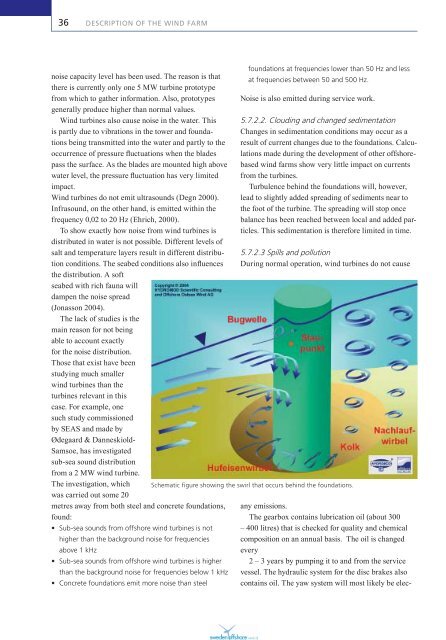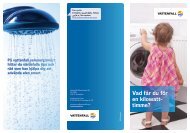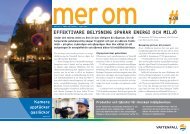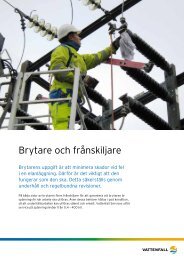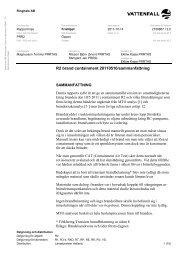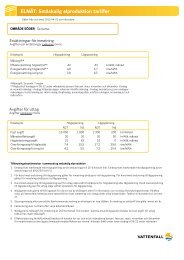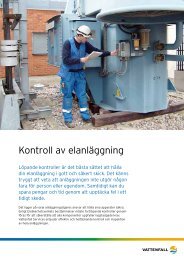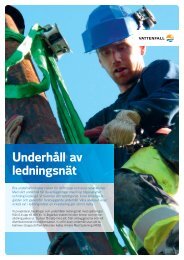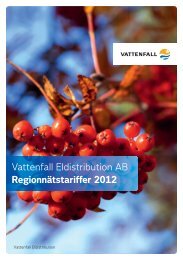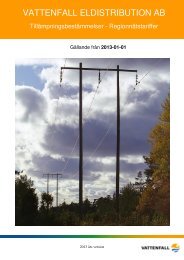This environmental impact assessment for Kriegers flak ... - Vattenfall
This environmental impact assessment for Kriegers flak ... - Vattenfall
This environmental impact assessment for Kriegers flak ... - Vattenfall
You also want an ePaper? Increase the reach of your titles
YUMPU automatically turns print PDFs into web optimized ePapers that Google loves.
36 DESCRIPTION OF THE WIND FARM<br />
noise capacity level has been used. The reason is that<br />
there is currently only one 5 MW turbine prototype<br />
from which to gather in<strong>for</strong>mation. Also, prototypes<br />
generally produce higher than normal values.<br />
Wind turbines also cause noise in the water. <strong>This</strong><br />
is partly due to vibrations in the tower and foundations<br />
being transmitted into the water and partly to the<br />
occurrence of pressure ß uctuations when the blades<br />
pass the surface. As the blades are mounted high above<br />
water level, the pressure ß uctuation has very limited<br />
<strong>impact</strong>.<br />
Wind turbines do not emit ultrasounds (Degn 2000).<br />
Infrasound, on the other hand, is emitted within the<br />
frequency 0,02 to 20 Hz (Ehrich, 2000).<br />
To show exactly how noise from wind turbines is<br />
distributed in water is not possible. Different levels of<br />
salt and temperature layers result in different distribution<br />
conditions. The seabed conditions also inß uences<br />
the distribution. A soft<br />
seabed with rich fauna will<br />
dampen the noise spread<br />
(Jonasson 2004).<br />
The lack of studies is the<br />
main reason <strong>for</strong> not being<br />
able to account exactly<br />
<strong>for</strong> the noise distribution.<br />
Those that exist have been<br />
studying much smaller<br />
wind turbines than the<br />
turbines relevant in this<br />
case. For example, one<br />
such study commissioned<br />
by SEAS and made by<br />
Ødegaard & Danneskiold-<br />
Samsoe, has investigated<br />
sub-sea sound distribution<br />
from a 2 MW wind turbine.<br />
The investigation, which<br />
was carried out some 20<br />
metres away from both steel and concrete foundations,<br />
found:<br />
• Sub-sea sounds from offshore wind turbines is not<br />
higher than the background noise <strong>for</strong> frequencies<br />
above 1 kHz<br />
• Sub-sea sounds from offshore wind turbines is higher<br />
than the background noise <strong>for</strong> frequencies below 1 kHz<br />
• Concrete foundations emit more noise than steel<br />
foundations at frequencies lower than 50 Hz and less<br />
at frequencies between 50 and 500 Hz.<br />
Noise is also emitted during service work.<br />
5.7.2.2. Clouding and changed sedimentation<br />
Changes in sedimentation conditions may occur as a<br />
result of current changes due to the foundations. Calculations<br />
made during the development of other offshorebased<br />
wind farms show very little <strong>impact</strong> on currents<br />
from the turbines.<br />
Turbulence behind the foundations will, however,<br />
lead to slightly added spreading of sediments near to<br />
the foot of the turbine. The spreading will stop once<br />
balance has been reached between local and added particles.<br />
<strong>This</strong> sedimentation is there<strong>for</strong>e limited in time.<br />
5.7.2.3 Spills and pollution<br />
During normal operation, wind turbines do not cause<br />
Schematic figure showing the swirl that occurs behind the foundations.<br />
any emissions.<br />
The gearbox contains lubrication oil (about 300<br />
– 400 litres) that is checked <strong>for</strong> quality and chemical<br />
composition on an annual basis. The oil is changed<br />
every<br />
2 – 3 years by pumping it to and from the service<br />
vessel. The hydraulic system <strong>for</strong> the disc brakes also<br />
contains oil. The yaw system will most likely be elec-


